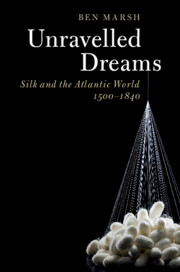Book contents
- Unravelled Dreams
- Unravelled Dreams
- Copyright page
- Dedication
- Contents
- Colour Plates
- Figures
- Maps
- Tables
- Acknowledgements
- 1 Prologue
- Part I Emergence
- Part II Persistence
- Part III Convergence
- 8 Convergence
- 9 Pennsylvania and Sericultural Revolution
- 10 Silk Production in the Wake of Revolution
- 11 Epilogue
- Select Bibliography
- Index
- Plate Section (PDF Only)
10 - Silk Production in the Wake of Revolution
from Part III - Convergence
Published online by Cambridge University Press: 08 October 2020
- Unravelled Dreams
- Unravelled Dreams
- Copyright page
- Dedication
- Contents
- Colour Plates
- Figures
- Maps
- Tables
- Acknowledgements
- 1 Prologue
- Part I Emergence
- Part II Persistence
- Part III Convergence
- 8 Convergence
- 9 Pennsylvania and Sericultural Revolution
- 10 Silk Production in the Wake of Revolution
- 11 Epilogue
- Select Bibliography
- Index
- Plate Section (PDF Only)
Summary
The independence of the United States blew apart the projected formula that had held sway for over 150 years in British regions persisting with sericulture – namely, that raw silk might be produced on the western side of the Atlantic and then manufactured on the eastern side of the Atlantic. Opportunistic schemes were proposed to create silk manufactures and to reorganise trade in silks, as American and European merchants and entrepreneurs sought to take advantage of the fraying of Anglo-American links, and to create new systems of production and distribution. Their earnest efforts revealed that there remained a lively appetite for silk goods amongst American consumers that soon re-emerged in the early 1780s: self-denial had been a means of revolution, but it was not an end. In the final quarter of the eighteenth century, political economists and silk producers alike made important strides towards ensuring a future for silk production, and they largely did so by linking it to American manufacturing. In contrast to the imperial regression in Atlantic domains, new expectations and new pressures developed among those regions of Europe that continued to fulfil sericulture’s prerequisites in the early nineteenth century.
Keywords
- Type
- Chapter
- Information
- Unravelled DreamsSilk and the Atlantic World, 1500–1840, pp. 389 - 424Publisher: Cambridge University PressPrint publication year: 2020



